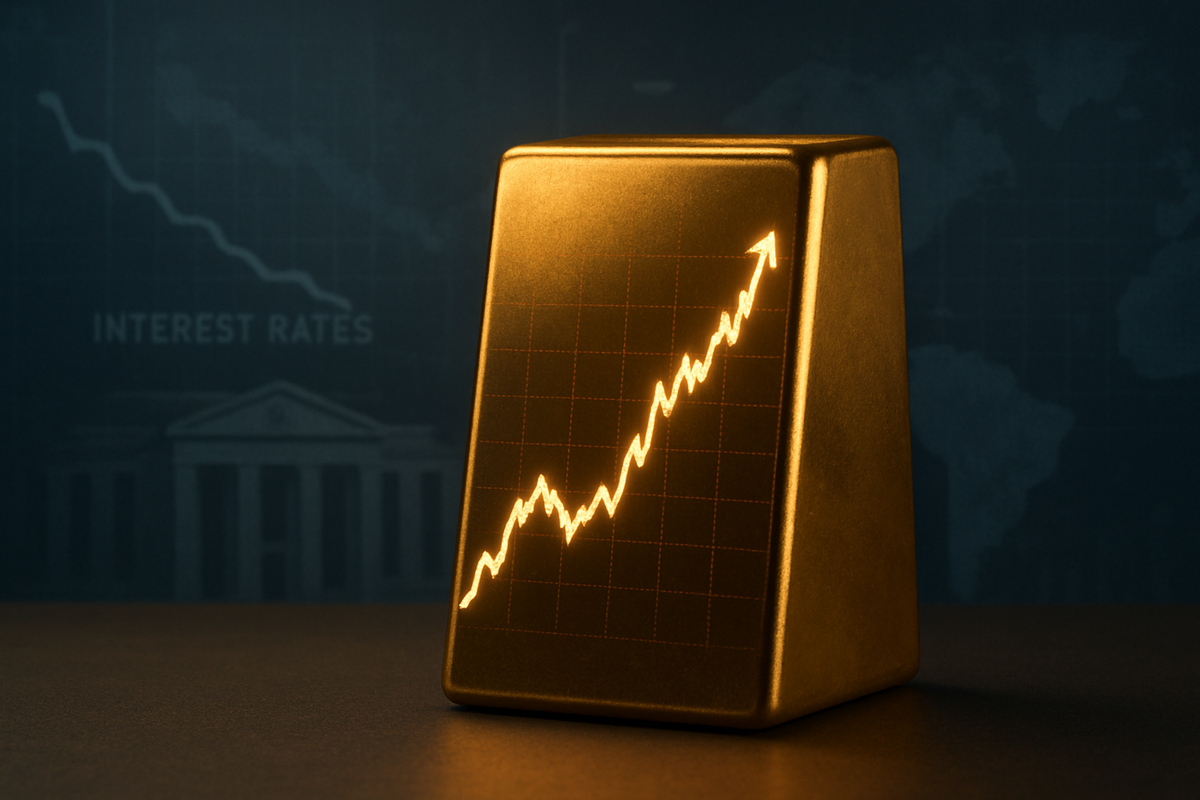
In an unprecedented financial spectacle, gold prices have shattered all previous records, surging past an astonishing $4,300 per ounce in mid-October 2025. This historic rally, seeing the precious metal climb nearly 60% year-to-date, marks a profound recalibration of global financial strategies and investor psychology, driven by a powerful confluence of anticipated Federal Reserve interest rate cuts, escalating global uncertainties, and intensifying US-China trade tensions. The yellow metal's ascent signifies a growing lack of confidence in traditional financial instruments and a fervent flight to safety amidst a volatile global landscape.
The immediate implication of this golden surge is a seismic shift in investment portfolios, with capital flowing rapidly into safe-haven assets. This rally is not merely a fleeting market phenomenon but reflects deep-seated concerns about economic fragility, persistent inflationary pressures, and a geopolitical environment fraught with risk. For public companies and the broader market, this means a re-evaluation of strategies, as some sectors stand to gain immensely, while others face significant headwinds.
The Unstoppable Ascent: Gold's Historic Rally to New Heights
Gold's journey to over $4,300 per ounce has been a relentless upward trajectory throughout 2025. The metal breached the significant $4,000 per ounce mark on October 8, 2025, a mere 36 days after crossing $3,500. By October 14, it reached an all-time high of $4,179.48, and on October 15, prices climbed above $4,200. The ultimate breach of $4,300 occurred on October 16, 2025, with spot gold touching $4,291.89 and Comex gold futures peaking at $4,254.80 per ounce, marking an almost 60% year-to-date gain.
This remarkable ascent has been underpinned by a series of events and market sentiments. The Federal Reserve's signaling of an interest-rate-cutting cycle in late August ignited retail investor interest, leading to robust inflows into gold-backed Exchange Traded Funds (ETFs). Central banks globally have also continued their sustained purchases, diversifying away from dollar-denominated reserves. The rally has also spurred a parallel surge in silver prices, which have likewise hit new all-time highs above $53 per ounce, indicating broad-based precious metals strength.
Key players driving this rally include central banks, large institutional investors seeking portfolio diversification, and individual retail investors looking for a hedge against inflation and economic instability. Initial market reactions have been overwhelmingly bullish, with analysts from major financial institutions like Bank of America and Goldman Sachs revising price targets upwards, some projecting gold to reach $5,000 per ounce by 2026. The U.S. dollar has also experienced downward pressure, making gold more attractive to international buyers.
Winners and Losers in the Golden Rush
A sustained gold rally to over $4,300 per ounce creates a clear delineation between beneficiaries and those facing increased costs or reduced demand. Companies directly involved in gold production, streaming, and investment are poised for substantial gains.
Gold Mining Companies are the most direct beneficiaries. Higher gold prices translate directly to increased revenue and expanded profit margins, assuming stable production costs. This can lead to higher dividends, share buybacks, and increased exploration budgets. Major players like Newmont Corporation (NYSE: NEM), the world's largest gold producer, and Barrick Gold Corporation (NYSE: GOLD, TSX: ABX), the second largest, stand to benefit significantly. Other prominent miners such as Agnico Eagle Mines Limited (NYSE: AEM, TSX: AEM), Kinross Gold Corporation (NYSE: KGC, TSX: K), and B2Gold Corp. (NYSE: BTG, TSX: BTO) will also see their fortunes rise.
Precious Metals Streaming and Royalty Companies also thrive in this environment. These firms, such as Wheaton Precious Metals Corp. (NYSE: WPM, TSX: WPM) and Franco-Nevada Corporation (NYSE: FNV, TSX: FNV), provide upfront financing to miners in exchange for future production or revenue. They benefit from higher gold prices without incurring operational risks. Investment vehicles like SPDR Gold Shares (NYSEArca: GLD) and iShares Gold Trust (NYSEArca: IAU), which hold physical gold, directly reflect the price increase, while ETFs like VanEck Vectors Gold Miners ETF (NYSEArca: GDX) offer exposure to the mining sector.
Conversely, Jewelry Retailers and Manufacturers are likely to be among the losers. Gold jewelry accounts for a significant portion of gold demand, and soaring prices mean increased input costs. This can lead to higher retail prices, reduced consumer demand, or squeezed profit margins. Companies like Signet Jewelers Limited (NYSE: SIG) and luxury brands such as Tiffany & Co. (part of LVMH Moët Hennessy Louis Vuitton SE, Euronext: MC) may face challenges. Similarly, Industrial Users of Gold, including electronics manufacturers like Apple (NASDAQ: AAPL) or Samsung Electronics (KRX: 005930), and suppliers to the dental industry like Dentsply Sirona (NASDAQ: XRAY), will incur higher material costs for gold components.
Wider Significance: A Global Economic Barometer
Gold's surge past $4,300 per ounce is more than just a commodity rally; it is a powerful barometer of the global economic and geopolitical climate. This historic rise fits into broader industry trends emphasizing safe-haven assets, de-dollarization, and the increasing role of digital assets.
The rally has significant ripple effects on other commodities. Silver, often termed "poor man's gold," has seen an even more dramatic increase, doubling in 18 months and breaking above $53 per ounce. Industrial metals like copper have also performed robustly, suggesting broad-based commodity strength driven by demand from clean energy transitions. This points to a broader inflationary environment and a flight from fiat currencies.
Inflation expectations are a key driver. Investors are increasingly turning to gold as a hedge against persistent inflationary pressures that show no signs of easing. The U.S. national debt surpassing $35 trillion and a debt-to-GDP ratio reaching approximately 123% fuel concerns about currency debasement, making gold an attractive store of value. This environment of economic uncertainty and perceived long-term inflation reinforces gold's traditional role.
Central bank policies are pivotal. Expectations of aggressive interest rate cuts from the U.S. Federal Reserve are a primary catalyst, with markets pricing in a near-certain 25-basis-point cut in October 2025 and further reductions into 2026. Lower interest rates reduce the opportunity cost of holding non-yielding gold. Furthermore, central banks globally are strategically diversifying their reserves away from dollar-denominated assets, accumulating over 1,000 tonnes of gold annually for the past three years. This structural shift, often termed "de-dollarization," provides consistent underlying demand.
Historically, gold has surged during periods of economic and political turmoil. The 1970s inflation and energy crisis, the 1980 gold rush, the Nixon Shock of 1971, the 2008 financial crisis, and the COVID-19 pandemic all saw gold rally as investors sought refuge. The current rally echoes these precedents, driven by escalating geopolitical tensions, government fiscal challenges (e.g., the ongoing U.S. government shutdown), and general economic uncertainty.
What Comes Next: Navigating the Golden Horizon
The short-term outlook for gold suggests a continuation of its bullish momentum. Expert forecasts anticipate gold climbing further, with projections ranging from $4,400 to $4,600 per ounce by mid-2026, and some analysts like Goldman Sachs targeting $4,900 by December 2026. This is largely predicated on the Federal Reserve's anticipated rate cuts and sustained safe-haven demand. However, potential for corrections exists if the U.S. dollar strengthens, mining output increases significantly, or equity markets rebound sharply.
In the long term, the outlook remains predominantly bullish. Structural factors such as persistent inflation, strong central bank buying, and ongoing geopolitical uncertainty are expected to underpin gold's sustained appeal well beyond 2026. Some optimistic long-term models even forecast prices potentially reaching $10,000+ per ounce within a decade, provided current trends persist. This indicates a fundamental shift in how investors view traditional currencies and store-of-value assets.
Key factors for investors to monitor include the pace and extent of Federal Reserve interest rate cuts, global inflation trends, the strength of the U.S. dollar, geopolitical stability (especially US-China trade relations and regional conflicts), and the continued demand from central banks. Any deviation from expected dovish monetary policy or a significant de-escalation of global tensions could temper gold's ascent.
Potential scenarios range from a bullish continuation, driven by persistent inflation and dovish central banks, to moderate volatility and consolidation. A stagflationary environment (high inflation, stagnant growth) would be exceptionally bullish for gold. A significant downturn, however, seems less likely given the current global landscape unless there's a dramatic and sustained strengthening of the U.S. dollar or a widespread resolution of major global uncertainties.
Wrap-Up: Gold's Enduring Allure in a Changing World
Gold's historic surge past $4,300 per ounce underscores its enduring role as the ultimate safe-haven asset in an increasingly uncertain world. The rally is a clear signal of investor anxiety, driven by expectations of significant Federal Reserve interest rate cuts, intensifying US-China trade tensions, and a complex web of global geopolitical instabilities. This confluence of factors has created a "perfect storm" for gold, propelling it to unprecedented highs and outperforming most other asset classes.
Moving forward, the market will closely watch central bank actions, particularly the Federal Reserve's commitment to monetary easing. The ongoing dynamics of global trade relations and the broader geopolitical landscape will continue to dictate safe-haven demand. For investors, gold offers a critical hedge against inflation and currency debasement, making it an indispensable component of diversified portfolios in these turbulent times.
The current golden era is not merely a cyclical event but reflects a deeper, structural shift in global finance, where traditional fiat currencies and sovereign debt are viewed with increasing skepticism. As central banks continue to diversify their reserves and investors seek tangible stores of value, gold's luster is set to shine even brighter in the months and years to come.
This content is intended for informational purposes only and is not financial advice.





